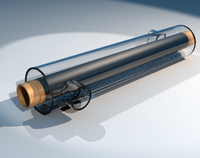
Photo from wikipedia
With great interest and enthusiasm we read the interesting article of Pesonen et al. [1] recently published in the journal about the measurement of core temperature with the new non-invasive… Click to show full abstract
With great interest and enthusiasm we read the interesting article of Pesonen et al. [1] recently published in the journal about the measurement of core temperature with the new non-invasive zero-heat-flux thermometer (3M Bair-Hugger). Although the device has been validated in many patient groups undergoing cardiac surgery [2, 3], vascular surgery [3], gynecological and trauma surgery [4], abdominal surgery [5] and during intensive care [6] it had not yet been validated in patients undergoing neurosurgery. Therefore the authors work is valuable because the measurement of the zero-heat-flux thermometer can be disturbed in many ways in patients undergoing neurosurgical procedures. Because the temperature sensor is located directly near the operative field the measurements may be influenced by washing and draping, the heat coming from the operating room lights or the drilling of the bone [7]. Furthermore craniotomy is associated with detachment of the brain from the cranium and can be associated with a loss of liquor between the brain surface and the dura. However, more important is the fact that brain temperature can be different from e.g. blood temperature, nasopharyngeal or bladder temperature especially under pathologic conditions. This has been shown several times in animals [8] and humans [9–11]. Most of the time brain temperature was higher than the temperature at the reference measurement site, especially after major brain injury or subarachnoid haemorrhage [12, 13]. As hyperthermia of brain tissue is known as a significant contributor to poor outcome after neuronal injury it is important to have a true brain tissue temperature estimation in these patients [13–15]. The estimation of brain temperature from standard monitoring sites does not accomplish this need. If the new zero-heatflux thermometer really measures core temperature at the surface of the brain—as it is assumed, than this would be a very interesting option for the monitoring and treatment of neurosurgical patients. By chance we had the possibility to measure core temperature with this zero-heat-flux thermometer in six patients undergoing neurosurgical intensive care with an implanted brain tissue temperature probe (RAUMEDIC AG, NEUROVENT-P-TEMP). The diagnosis of these patients and locations of the brain tissue temperature probe are given in Table 1. In these six patients brain temperature was different to the standard monitoring sites. Upon 110 measurements mean brain temperature was 0.49 °C (Standard deviation 0.26 °C) higher than core temperature measured with the zero-heat-flux thermometer, whereas bladder temperature and the temperature measured with the zero-heat-flux thermometer showed equal temperatures with a mean difference of − 0.05 °C and a standard deviation of 0.18 °C. Figures 1 and 2 shows two of the six measurements. Based on the data of Pesonen et al. [1] and these data we assume that the new zero-heat-flux thermometer measures core temperature in neurosurgical patients with a good accuracy. However, we do not think that the device really measures brain temperature. Maybe the focus of temperature monitoring is not so deep as assumed. If brain temperature shall be used for the management of patients with intracranial pathology direct measurement of brain temperature is still necessary. * Anselm Bräuer [email protected]
Journal Title: Journal of Clinical Monitoring and Computing
Year Published: 2019
Link to full text (if available)
Share on Social Media: Sign Up to like & get
recommendations!